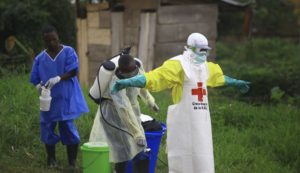The World Bank Group has reached out to catastrophe risk modelling firms as it prepares to begin development on the next phase of its Pandemic Emergency Financing Facility, PEF 2.0.

A health worker is disinfected at an Ebola treatment centre in Beni, Eastern Congo (AP Photo/Al-hadji Kudra Maliro)
In response to the high financial, social and economic loss driven by outbreaks of infectious disease, such as the 2014 Ebola outbreak in West Africa, the PEF was announced in 2016 by the World Bank as a facility able to channel capital to member countries of the International Development Association (IDA) facing a major virus outbreak with pandemic potential.
The World Bank subsequently turned to the global reinsurance industry and broader risk transfer markets to launch specialist bonds, also known as catastrophe bonds, designed to provide financial support to the PEF.
The transaction was oversubscribed by 200%, and underlined the positive response from the investor community.
This enabled the World Bank to price the deal below initial guidance from the marketplace, with the total volume of risk transferred to the market via derivatives and bonds standing at $425 million.
Of the $425 million transferred to the global risk transfer market, $320 million was in the form of pandemic cat bonds, with an additional $105 million of pandemic risk linked swaps, or derivatives.
Now, in anticipation for the scheduled maturity of the PEF 1.0 parametric insurance coverage in July 2020, the World Bank along with selected re/insurance brokers is reviewing all aspects of the the facility’s structure.
The World Bank hopes this move will improve the program where necessary for the anticipated commencement of marketing the PEF 2.0 risk transfer mechanism around May 2020.
This includes securing a risk modelling firm to conduct a series of iterative risk modelling exercises and construct a model capable of underpinning the risk transfer window for PEF 2.0.


